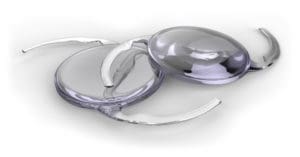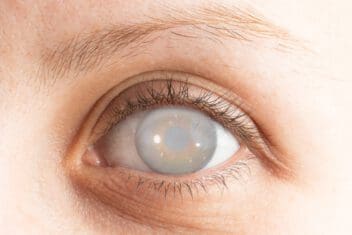Multifocal IOLs: Are Mutifocal IOL Implants Right For You?
Home / Guide to Cataract Surgery /
Last Updated:
Cataract surgery involves replacing the eye’s cloudy lens with a synthetic intraocular lens (IOL) to restore clear vision. One of the choices available to patients is a multifocal IOL, designed to offer different levels of vision correction, allowing clear vision at various distances. This lens is also available to patients who do not have cataracts but are interested in lens replacement surgery (refractive lens exchange) to correct vision problems.
Table of Contents
What Is a Multifocal IOL?
A multifocal lens is an artificial intraocular lens (IOL) designed to provide focus for both near and distance vision. Unlike standard monofocal lenses, which only correct for a single type of vision, multifocal lenses have multiple focal points, allowing patients to see clearly at multiple distances without glasses or contact lenses. They are typically used in cataract surgery to restore the refractive properties of the lens after its removal.

How Does a Multifocal IOL Work?
Multifocal IOLs use different optical powers across the lens. Manufacturers etch concentric rings on the surface of the lens. These rings are designed to focus light from different distances onto the retina. Eye muscles pull on the lens when you need to focus, allowing you to see both near and distant objects more clearly.
Monofocal vs Multifocal IOL
The choice between a basic monofocal or multifocal IOLs depends on your visual needs, lifestyle, and willingness to accept potential visual trade-offs. Here’s a list of what each lens can do for you and the most relevant facts about them:
Don't Let Cataracts Limit Your Life
With 135+ locations and over 2.5 million procedures performed, our board-certified cataract surgeons have the experience you can trust. Take the first step toward seeing clearly again.
Restore Clarity to your World Today.
Monofocal IOLs:
- Provide clear vision at a single distance, usually for distance vision
- Patients will likely need glasses for near or intermediate vision
- Considered the standard or traditional IOL option for cataract surgery
- Generally less expensive than multifocal IOLs, often covered by insurance
Multifocal IOLs:
- Provide clear vision at multiple distances – near, intermediate, and far
- Aim to reduce or eliminate the need for glasses after cataract surgery
- More expensive than monofocal IOLs, often not fully covered by insurance
- May have a higher risk of visual side effects like glare, halos, and reduced contrast sensitivity compared to monofocal IOLs, although the risk is very low.
- Newer multifocal lens designs have improved on these visual side effects compared to older models.
Accommodating vs Multifocal IOL
Accommodating IOLs are a different type of IOL designed to restore the eye’s natural ability to focus on objects at varying distances. Unlike multifocal IOLs, accommodating IOLs are designed to move within the eye to change focus distances, mimicking the natural accommodation process of the eye. These lenses are an effective treatment for presbyopia, significantly reducing the need for reading glasses.
If you are interested in having a fuller range of vision without having to use glasses after surgery, both multifocal and accommodating lenses could be a viable option. You should discuss your case with your surgeon, who may recommend one or the other depending on your visual and lifestyle needs.
Multifocal IOL vs EDOF IOL

There is another type of premium IOL that provides an extended range of clear vision: the extended depth of focus or “EDOF” intraocular lens. EDOF lenses are sometimes referred to as “multifocal” lenses, but the two types work in different ways.
EDOF lenses have one focal point (like monofocals) but they incorporate special light-shaping technology to stretch the total range of this focus. This way, they provide good vision from near to distance. The transition between ranges is more seamless, as it all occurs within the same focal area. The downside is some loss of contrast sensitivity and the need for reading glasses in dim light conditions.
Multifocal IOL Options
The first multifocal IOLs offered only two focal points for distance and near vision. Popular models included the Tecnis Multifocal, the AcrySof ReSTOR and the ReZoom IOL. While these lenses offer good vision outcomes, the have been now outperformed by trifocal IOLs, which provide clear vision at near, intermediate and distance ranges.
In the United States, the only trifocal IOL commercially available is the PanOptix trifocal IOL by Alcon. This lens represents one of the best options in vision correction for cataract surgery.
Multifocal Toric Lens
Regular IOLs (whether basic or premium) do not correct astigmatism. But most IOL models have an astigmatism-correcting version called a toric IOL. The term “toric” refers to the special shape of the lens, which corrects the uneven curvature of the eye that causes astigmatism. The Trifocal IOL has a toric version, so patients with astigmatism who want a multifocal lens can obtain their desired vision correction.
Pros & Cons: Are Multifocal IOLs Worth It?
Multifocal lenses are a great option for patients who desire more spectacle independence after cataract surgery, but they are not the only lens with this feature. Depending on your health, vision needs and lifestyle preferences, other lenses might be preferable.
A big factor to consider before your surgery is cost. Multifocal lenses are not covered by insurance, and represent a significant investment. However, the results are worth it for many patients, and financing options make it easier to afford.
| Pros | Cons |
|---|---|
| Improved intermediate, far, and near distances | Close distance vision not as sharp as with monofocal IOLs |
| Most people no longer need corrective lenses | Difficulty reading in dim light (might require reading glasses) |
| Long-lasting results with no upkeep | Possible halo and glare when compared to monofocal IOLs |
Multifocal IOL Advantages
- Multifocal IOLs all work to improve intermediate, far, and near distances.
- In many cases, after having the lenses implanted, people no longer need to wear corrective lenses to see clearly.
- The results are usually long-lasting, and there is no upkeep since the lenses are embedded in the eye.
Researchers say close to 96 percent of people with multifocal IOLs achieve vision scores of 20/40 or better, and more than 51 percent get vision scores of 20/20. People like this may not need to wear glasses again.
Multifocal IOL Disadvantages
There are a few disadvantages to consider before getting a Multifocal IOL.
- Seeing at close distances is sometimes an issue for people with multifocal IOLs. However, reading glasses usually correct this problem.
- People who get these lenses as part of cataract surgery may find it hard to read in dim light.
- While rare, some people develop halos and glare surrounding lights after dark, which can interfere with safe driving at night. Newer versions are more effective and less likely to cause this problem.
Don't Let Cataracts Limit Your Life
With 135+ locations and over 2.5 million procedures performed, our board-certified cataract surgeons have the experience you can trust. Take the first step toward seeing clearly again.
Restore Clarity to your World Today.
References
- Quick Facts. (December 2021). The Vision Council.
- Multifocal Intraocular Lenses: Types, Outcomes, Complications, and How to Solve Them. (October 2017). Taiwan Journal of Ophthalmology.
- Efficacy and Safety of Multifocal Intraocular Lenses Following Cataract and Refractive Lens Exchange: Meta-Analysis of Peer-Reviewed Publications. (February 2016). Journal of Cataract and Refractive Surgery.
- Effectiveness of Multifocal and Monofocal Intraocular Lenses for Cataract Surgery and Lens Replacement: A Systematic Review and Meta-Analysis. (January 2019). Graefe’s Archive for Clinical and Experimental Ophthalmology.
- Cataract Surgery: Risks, Recovery, Costs. (July 2022). American Academy of Ophthalmology.
- What Is the Success Rate for Cataract Surgery? (February 2014). American Academy of Ophthalmology.
This content is for informational purposes only. It may have been reviewed by a licensed physician, but is not intended to serve as a substitute for professional medical advice. Always consult your healthcare provider with any health concerns. For more, read our Privacy Policy and Editorial Policy.
